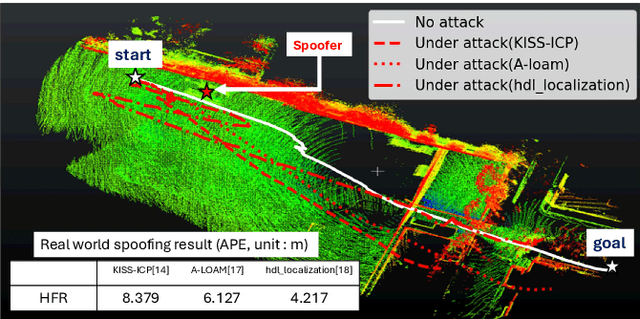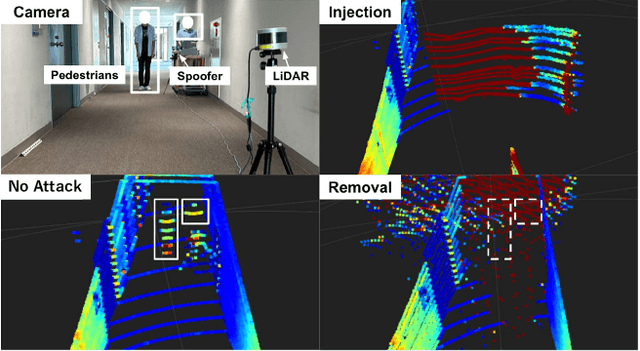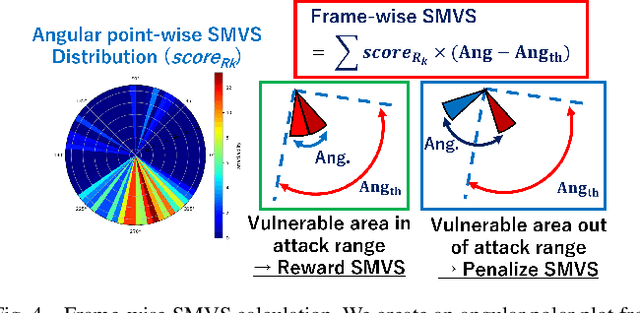Takami Sato
Interior-Point Vanishing Problem in Semidefinite Relaxations for Neural Network Verification
Jun 12, 2025Abstract:Semidefinite programming (SDP) relaxation has emerged as a promising approach for neural network verification, offering tighter bounds than other convex relaxation methods for deep neural networks (DNNs) with ReLU activations. However, we identify a critical limitation in the SDP relaxation when applied to deep networks: interior-point vanishing, which leads to the loss of strict feasibility -- a crucial condition for the numerical stability and optimality of SDP. Through rigorous theoretical and empirical analysis, we demonstrate that as the depth of DNNs increases, the strict feasibility is likely to be lost, creating a fundamental barrier to scaling SDP-based verification. To address the interior-point vanishing, we design and investigate five solutions to enhance the feasibility conditions of the verification problem. Our methods can successfully solve 88% of the problems that could not be solved by existing methods, accounting for 41% of the total. Our analysis also reveals that the valid constraints for the lower and upper bounds for each ReLU unit are traditionally inherited from prior work without solid reasons, but are actually not only unbeneficial but also even harmful to the problem's feasibility. This work provides valuable insights into the fundamental challenges of SDP-based DNN verification and offers practical solutions to improve its applicability to deeper neural networks, contributing to the development of more reliable and secure systems with DNNs.
SLAMSpoof: Practical LiDAR Spoofing Attacks on Localization Systems Guided by Scan Matching Vulnerability Analysis
Feb 19, 2025



Abstract:Accurate localization is essential for enabling modern full self-driving services. These services heavily rely on map-based traffic information to reduce uncertainties in recognizing lane shapes, traffic light locations, and traffic signs. Achieving this level of reliance on map information requires centimeter-level localization accuracy, which is currently only achievable with LiDAR sensors. However, LiDAR is known to be vulnerable to spoofing attacks that emit malicious lasers against LiDAR to overwrite its measurements. Once localization is compromised, the attack could lead the victim off roads or make them ignore traffic lights. Motivated by these serious safety implications, we design SLAMSpoof, the first practical LiDAR spoofing attack on localization systems for self-driving to assess the actual attack significance on autonomous vehicles. SLAMSpoof can effectively find the effective attack location based on our scan matching vulnerability score (SMVS), a point-wise metric representing the potential vulnerability to spoofing attacks. To evaluate the effectiveness of the attack, we conduct real-world experiments on ground vehicles and confirm its high capability in real-world scenarios, inducing position errors of $\geq$4.2 meters (more than typical lane width) for all 3 popular LiDAR-based localization algorithms. We finally discuss the potential countermeasures of this attack. Code is available at https://github.com/Keio-CSG/slamspoof
Revisiting Physical-World Adversarial Attack on Traffic Sign Recognition: A Commercial Systems Perspective
Sep 15, 2024Abstract:Traffic Sign Recognition (TSR) is crucial for safe and correct driving automation. Recent works revealed a general vulnerability of TSR models to physical-world adversarial attacks, which can be low-cost, highly deployable, and capable of causing severe attack effects such as hiding a critical traffic sign or spoofing a fake one. However, so far existing works generally only considered evaluating the attack effects on academic TSR models, leaving the impacts of such attacks on real-world commercial TSR systems largely unclear. In this paper, we conduct the first large-scale measurement of physical-world adversarial attacks against commercial TSR systems. Our testing results reveal that it is possible for existing attack works from academia to have highly reliable (100\%) attack success against certain commercial TSR system functionality, but such attack capabilities are not generalizable, leading to much lower-than-expected attack success rates overall. We find that one potential major factor is a spatial memorization design that commonly exists in today's commercial TSR systems. We design new attack success metrics that can mathematically model the impacts of such design on the TSR system-level attack success, and use them to revisit existing attacks. Through these efforts, we uncover 7 novel observations, some of which directly challenge the observations or claims in prior works due to the introduction of the new metrics.
Exploring Backdoor Attacks against Large Language Model-based Decision Making
May 27, 2024



Abstract:Large Language Models (LLMs) have shown significant promise in decision-making tasks when fine-tuned on specific applications, leveraging their inherent common sense and reasoning abilities learned from vast amounts of data. However, these systems are exposed to substantial safety and security risks during the fine-tuning phase. In this work, we propose the first comprehensive framework for Backdoor Attacks against LLM-enabled Decision-making systems (BALD), systematically exploring how such attacks can be introduced during the fine-tuning phase across various channels. Specifically, we propose three attack mechanisms and corresponding backdoor optimization methods to attack different components in the LLM-based decision-making pipeline: word injection, scenario manipulation, and knowledge injection. Word injection embeds trigger words directly into the query prompt. Scenario manipulation occurs in the physical environment, where a high-level backdoor semantic scenario triggers the attack. Knowledge injection conducts backdoor attacks on retrieval augmented generation (RAG)-based LLM systems, strategically injecting word triggers into poisoned knowledge while ensuring the information remains factually accurate for stealthiness. We conduct extensive experiments with three popular LLMs (GPT-3.5, LLaMA2, PaLM2), using two datasets (HighwayEnv, nuScenes), and demonstrate the effectiveness and stealthiness of our backdoor triggers and mechanisms. Finally, we critically assess the strengths and weaknesses of our proposed approaches, highlight the inherent vulnerabilities of LLMs in decision-making tasks, and evaluate potential defenses to safeguard LLM-based decision making systems.
Invisible Reflections: Leveraging Infrared Laser Reflections to Target Traffic Sign Perception
Jan 07, 2024



Abstract:All vehicles must follow the rules that govern traffic behavior, regardless of whether the vehicles are human-driven or Connected Autonomous Vehicles (CAVs). Road signs indicate locally active rules, such as speed limits and requirements to yield or stop. Recent research has demonstrated attacks, such as adding stickers or projected colored patches to signs, that cause CAV misinterpretation, resulting in potential safety issues. Humans can see and potentially defend against these attacks. But humans can not detect what they can not observe. We have developed an effective physical-world attack that leverages the sensitivity of filterless image sensors and the properties of Infrared Laser Reflections (ILRs), which are invisible to humans. The attack is designed to affect CAV cameras and perception, undermining traffic sign recognition by inducing misclassification. In this work, we formulate the threat model and requirements for an ILR-based traffic sign perception attack to succeed. We evaluate the effectiveness of the ILR attack with real-world experiments against two major traffic sign recognition architectures on four IR-sensitive cameras. Our black-box optimization methodology allows the attack to achieve up to a 100% attack success rate in indoor, static scenarios and a >80.5% attack success rate in our outdoor, moving vehicle scenarios. We find the latest state-of-the-art certifiable defense is ineffective against ILR attacks as it mis-certifies >33.5% of cases. To address this, we propose a detection strategy based on the physical properties of IR laser reflections which can detect 96% of ILR attacks.
Intriguing Properties of Diffusion Models: A Large-Scale Dataset for Evaluating Natural Attack Capability in Text-to-Image Generative Models
Aug 30, 2023



Abstract:Denoising probabilistic diffusion models have shown breakthrough performance that can generate more photo-realistic images or human-level illustrations than the prior models such as GANs. This high image-generation capability has stimulated the creation of many downstream applications in various areas. However, we find that this technology is indeed a double-edged sword: We identify a new type of attack, called the Natural Denoising Diffusion (NDD) attack based on the finding that state-of-the-art deep neural network (DNN) models still hold their prediction even if we intentionally remove their robust features, which are essential to the human visual system (HVS), by text prompts. The NDD attack can generate low-cost, model-agnostic, and transferrable adversarial attacks by exploiting the natural attack capability in diffusion models. Motivated by the finding, we construct a large-scale dataset, Natural Denoising Diffusion Attack (NDDA) dataset, to systematically evaluate the risk of the natural attack capability of diffusion models with state-of-the-art text-to-image diffusion models. We evaluate the natural attack capability by answering 6 research questions. Through a user study to confirm the validity of the NDD attack, we find that the NDD attack can achieve an 88% detection rate while being stealthy to 93% of human subjects. We also find that the non-robust features embedded by diffusion models contribute to the natural attack capability. To confirm the model-agnostic and transferrable attack capability, we perform the NDD attack against an AD vehicle and find that 73% of the physically printed attacks can be detected as a stop sign. We hope that our study and dataset can help our community to be aware of the risk of diffusion models and facilitate further research toward robust DNN models.
Does Physical Adversarial Example Really Matter to Autonomous Driving? Towards System-Level Effect of Adversarial Object Evasion Attack
Aug 23, 2023



Abstract:In autonomous driving (AD), accurate perception is indispensable to achieving safe and secure driving. Due to its safety-criticality, the security of AD perception has been widely studied. Among different attacks on AD perception, the physical adversarial object evasion attacks are especially severe. However, we find that all existing literature only evaluates their attack effect at the targeted AI component level but not at the system level, i.e., with the entire system semantics and context such as the full AD pipeline. Thereby, this raises a critical research question: can these existing researches effectively achieve system-level attack effects (e.g., traffic rule violations) in the real-world AD context? In this work, we conduct the first measurement study on whether and how effectively the existing designs can lead to system-level effects, especially for the STOP sign-evasion attacks due to their popularity and severity. Our evaluation results show that all the representative prior works cannot achieve any system-level effects. We observe two design limitations in the prior works: 1) physical model-inconsistent object size distribution in pixel sampling and 2) lack of vehicle plant model and AD system model consideration. Then, we propose SysAdv, a novel system-driven attack design in the AD context and our evaluation results show that the system-level effects can be significantly improved, i.e., the violation rate increases by around 70%.
Revisiting LiDAR Spoofing Attack Capabilities against Object Detection: Improvements, Measurement, and New Attack
Mar 19, 2023



Abstract:LiDAR (Light Detection And Ranging) is an indispensable sensor for precise long- and wide-range 3D sensing, which directly benefited the recent rapid deployment of autonomous driving (AD). Meanwhile, such a safety-critical application strongly motivates its security research. A recent line of research demonstrates that one can manipulate the LiDAR point cloud and fool object detection by firing malicious lasers against LiDAR. However, these efforts face 3 critical research gaps: (1) evaluating only on a specific LiDAR (VLP-16); (2) assuming unvalidated attack capabilities; and (3) evaluating with models trained on limited datasets. To fill these critical research gaps, we conduct the first large-scale measurement study on LiDAR spoofing attack capabilities on object detectors with 9 popular LiDARs in total and 3 major types of object detectors. To perform this measurement, we significantly improved the LiDAR spoofing capability with more careful optics and functional electronics, which allows us to be the first to clearly demonstrate and quantify key attack capabilities assumed in prior works. However, we further find that such key assumptions actually can no longer hold for all the other (8 out of 9) LiDARs that are more recent than VLP-16 due to various recent LiDAR features. To this end, we further identify a new type of LiDAR spoofing attack that can improve on this and be applicable to a much more general and recent set of LiDARs. We find that its attack capability is enough to (1) cause end-to-end safety hazards in simulated AD scenarios, and (2) remove real vehicles in the physical world. We also discuss the defense side.
Learning Representation for Anomaly Detection of Vehicle Trajectories
Mar 09, 2023Abstract:Predicting the future trajectories of surrounding vehicles based on their history trajectories is a critical task in autonomous driving. However, when small crafted perturbations are introduced to those history trajectories, the resulting anomalous (or adversarial) trajectories can significantly mislead the future trajectory prediction module of the ego vehicle, which may result in unsafe planning and even fatal accidents. Therefore, it is of great importance to detect such anomalous trajectories of the surrounding vehicles for system safety, but few works have addressed this issue. In this work, we propose two novel methods for learning effective and efficient representations for online anomaly detection of vehicle trajectories. Different from general time-series anomaly detection, anomalous vehicle trajectory detection deals with much richer contexts on the road and fewer observable patterns on the anomalous trajectories themselves. To address these challenges, our methods exploit contrastive learning techniques and trajectory semantics to capture the patterns underlying the driving scenarios for effective anomaly detection under supervised and unsupervised settings, respectively. We conduct extensive experiments to demonstrate that our supervised method based on contrastive learning and unsupervised method based on reconstruction with semantic latent space can significantly improve the performance of anomalous trajectory detection in their corresponding settings over various baseline methods. We also demonstrate our methods' generalization ability to detect unseen patterns of anomalies.
Semi-supervised Semantics-guided Adversarial Training for Trajectory Prediction
May 27, 2022



Abstract:Predicting the trajectories of surrounding objects is a critical task in self-driving and many other autonomous systems. Recent works demonstrate that adversarial attacks on trajectory prediction, where small crafted perturbations are introduced to history trajectories, may significantly mislead the prediction of future trajectories and ultimately induce unsafe planning. However, few works have addressed enhancing the robustness of this important safety-critical task. In this paper, we present the first adversarial training method for trajectory prediction. Compared with typical adversarial training on image tasks, our work is challenged by more random inputs with rich context, and a lack of class labels. To address these challenges, we propose a method based on a semi-supervised adversarial autoencoder that models disentangled semantic features with domain knowledge and provides additional latent labels for the adversarial training. Extensive experiments with different types of attacks demonstrate that our semi-supervised semantics-guided adversarial training method can effectively mitigate the impact of adversarial attacks and generally improve the system's adversarial robustness to a variety of attacks, including unseen ones. We believe that such semantics-guided architecture and advancement in robust generalization is an important step for developing robust prediction models and enabling safe decision making.
 Add to Chrome
Add to Chrome Add to Firefox
Add to Firefox Add to Edge
Add to Edge